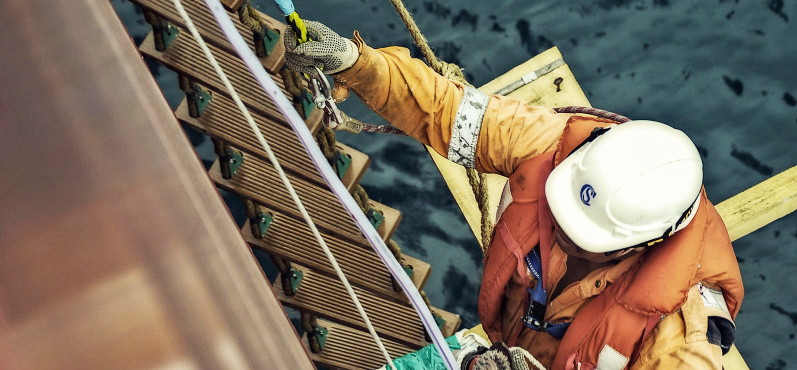Vessels generally move a lot in rough sea conditions. Under these circumstances, it is important to take the necessary time and ensure that everyone can move safely on board.
Rush often causes accidents
One recurring cause of falls is rush. One example is when a person takes two steps at a time, misses the step, loses the grip of the handrail and falls. If the person is high up in a stairway/ladder, such a fall can cause major injuries. And if it happens inside a vessel, the person is not likely to be wearing personal protective equipment.
Occasionally, you can miss a step or two and fall.
Keep your arms free when boarding a vessel
When signing on or off a vessel, and bringing one or two bags, you should still keep your hans on the handrail when entering the vessel. Bags often have shoulder straps, which means that they can be worn on the back, like a backpack. If you do so, you can keep your hands on both handrails or support yourself if you fall.
Some ladders are built with one or two square bars as steps. These steel bars have sharp edges and are intended to provide a good grip whem climbing the ladder. Inclined ladders and stairways with a different type of steps must be provided with a non-slip coating. Here it is vital, especially for external stairs, that the coating is intact and not worn, and that it is not covered in oil spills, fish guts or other substances. If it is, the coating must be replaced and be kept clean at all times.
Non-slip coating
On floors/decks, a non-slip coating must be applied to escape routes and areas that are regularly frequented by persons, and where the grip is likely to be poor.
Accommodation stairway steps must be provided with non-slip edges. There must be sufficient lighting on ladders/stairways to make it possible to see all steps, both when going down and up and when it is dark outside, without casting shadows while walking.
Proper safety boots
Safety boots used in external areas on a vessel, and in any factories or similar, must have a non-slip sole. If the sole is worn out, the safety boots must be replaced.
Accidents, like the one mentioned above, are not to be taken lightly. Falls caused by trips or slips could lead to serious physical injuries and, in the worst case scenario, death.
The main causes of slips, trips and falls are:
- slippery deck
- careless accessing, rush
- lack of grating, railing or other barriers
- lack of warning signs
- insufficient use of personal protective equipment (worn safety boots and missing helmets)
- failure to stay away from barriers
- insufficient focus on the work that is carried out
- SJA (Safe Job Analysis) not sufficiently thorough before performing the job
Some of this could be avoided by:
- cleaning up after having completed the job and removing spills of oil or other products that make surfaces slippery and could cause falls
- using the provided escape routes and avoiding shortcuts
- using safety boots with non-slip soles and suitable personal protective equipment when working at height (climbing harness)
- being alert and vigilant of the safety in all aspects of the work situation
- conducting a safe job analysis (SJA) before the work operation starts

